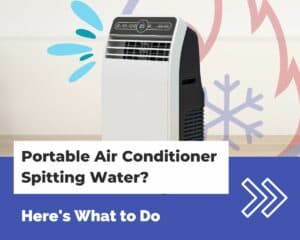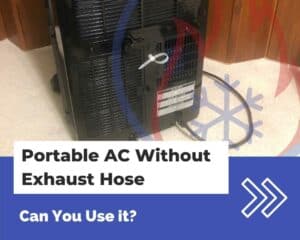HVAC Training Shop is reader-supported. As an Amazon Associate, I earn from qualifying purchases.
Having your air conditioner go down during the hot months is an unfortunate event that needs to be addressed quickly.
Fortunately, there are a few things that you can do to get your portable air conditioner back up and running. Depending on how your air conditioner is behaving, you can try one or more things to correct the issue.
In this guide, I’ll go over some troubleshooting steps that you can take when your air conditioner stops cooling.
Your portable air conditioner is not cooling
If your portable air conditioner is blowing air but it’s not cold, then there are a few things that can cause that. Below, I’ll go over a few things that you can check before calling an expert.
Check the AC mode setting
First, you’ll want to check that the air conditioner mode is set to the correct setting. Most portable air conditioners have three settings: “Cool”, “Dry”, and “Fan”. Ensure that your AC is set to “Cool” mode and see if it starts blowing cold.

Check the thermostat temperature
Another thing to check is if your portable AC is set to a low enough temperature to enable cooling. For instance, if your room’s temperature is 70 degrees, but your AC’s thermostat is set to 80 degrees, then the AC won’t cool.
Use the thermostat controls on your AC to set the temperature as low as it can go and see if it starts cooling.
Your portable air conditioner is cooling… but not enough
If your portable air conditioner is blowing cold but your room isn’t getting any cooler, many different things can cause that. This is a very common issue, and it can sometimes be an easy fix.
Close all doors and windows
This may sound obvious, but your portable AC won’t be able to cool your room down if the doors and windows are open. Open doors and windows provide a clear path for warm air from the outside your room to infiltrate your conditioned space.
Be sure to shut any doors and windows to minimize air transfer between your conditioned and unconditioned spaces. Even small gaps between windows and underneath doors can let cool air escape from your room.
Vent the exhaust hose outside
One of the most common issues of insufficient cooling from a portable AC is a leaky exhaust hose. The exhaust hose needs to be able to vent hot air to the outside of your home in order for your portable AC to work. If your exhaust hose is leaking hot air or is not blowing outside then the heat that your AC is removing is going right back into your room.
If your exhaust hose is venting outside, may be helpful to go outside and confirm that hot air is blowing out of it from the other side. Sometimes, obstructions can block airflow such as leaves, debris, or bird nests!
There is too much heat load
Sometimes, it is just plain too hot outside for your air conditioner to keep up! If there’s too much heat load coming in from external sources, your portable AC will struggle to cool your space. In this situation, the only solution is to get a larger-sized AC. This is why it is important to make sure that your portable AC is sized properly to the room that you need to cool.
If your room is exposed to sunlight, then that will dramatically increase the heat load. This is why rooms that are exposed to the “afternoon sun” get much hotter than rooms that aren’t. One solution is to use curtains or blinds to block sunlight from getting into your room.
Sometimes, just blocking the sun is not enough. In this case, you’ll have to ensure that your portable AC is rated for more cooling than normal.
Sources of heat load can come from inside your home as well. Electronics that are powered on contribute to the heat load inside your room. If you are trying to cool your kitchen, then the stove and oven will add lots of heat to your space if they’re on.
Your portable air conditioner won’t start
Did you try turning on your portable AC, but it didn’t start at all?
This could be due to one of several reasons:
No power to AC unit
The most common cause of a portable air conditioner that wonʻt start is that it does not have any power. Check to see if your air conditioner is plugged in.
If it’s plugged in but still not starting, you’ll want to check that the outlet has power. You can use a voltage detector to test whether your power outlet has voltage.
Another thing to check is the circuit breakers. Make sure that the circuit breakers are on and not tripped:
- Check the circuit breaker that is built into your AC’s plug.
- Check the circuit breaker inside of your electrical panel.
If one of the circuit breakers are tripped, then it may indicate another issue with your AC unit.
Try resetting the circuit breaker and turn back on your AC. Listen to your AC as it starts up– see if you can pinpoint any noisy components. In many cases, a malfunctioning component in your AC will cause a circuit breaker to trip.
The condensate tank is full
Air conditioners have a secondary purpose– to remove moisture from the air. Cool air isnʻt able to hold as much moisture as warm air, so water comes out of the air as it cools down.
Water condensate collects in a tank as the air is cooled in your portable AC. Some portable ACs have a hose that drains condensate directly out of the unit. In this case, you’ll want to ensure that the condensate hose is clear and draining properly.
Most times this is not an issue, since the condensate tends to evaporate back into your room as your AC runs. However, condensate will accumulate inside the tank, particularly on hot, muggy days.
To empty the condensate tank, you’ll need to shut off and unplug the AC. Next, put it on an elevated surface such as a stool.
Ensure that the drain spout is hanging over the edge of the surface. Place a plastic container underneath the spout. You want to make sure that the container is large enough to collect all the water that comes out of the tank of your AC.
Most portable ACs have condensate tanks that can hold about 1 liter of water, so make sure that your container can hold more than that.
Finally, open the cap on the spout and allow the water to drain out. When all the water is drained, replace the cap and return the AC to its initial location.
Some portable ACs have a bucket inside the unit that you can remove and dump out in your sink. In that case, you don’t need to elevate your portable AC, you need to remove the bucket and discard the water.

Portable air conditioner warning lights
Portable ACs almost always have an indicator that lets you know when its condensate tank is full. The alarm codes that your portable AC makes can be hard to decipher.
Some people don’t even know what their AC is trying to tell them when it starts flashing and beeping. In this case, it is best to consult the owner’s manual for your AC to figure out what the beeps and flashes mean.
Low airflow from your portable air conditioner
Sometimes your portable air conditioner blows cold air… but it’s not blowing as much air as it usually does. In this case, it could be one of several things:
Dirty air filter in portable air conditioner
A dirty air filter in your portable air conditioner will impede the airflow coming from your AC. Cleaning the air filter regularly will ensure that your air conditioner is getting adequate airflow.
To clean the air filter:
- Power your AC off. Ensure that the AC is powered completely off before removing the air filter.
- Remove the plastic grille that is covering the filter. Sometimes the grille gets a little dusty so clean it if needed.
- Remove the air filter. Be careful to ensure that any caked-on dust or debris does not fall off the filter to the floor of your home. It is a good idea to put the filter in a trash bag so it won’t get your floors dirty while you move it across your house.
- Clean the filter out. If the filter is lightly soiled, then you can simply dust it off to remove most of the debris.
For air filters that are really dirty or have caked-on debris, then you will need to rinse it out with water in your sink. Ensure the filter is completely clean and dry before replacing it back into your air conditioner. - Replace the air filter and grille. After everything is completely dry, reinstall the air filter and grille back on the air conditioner.
The fan is not blowing hard
Low airflow is also caused by issues from the fan or fan motor.
Be sure to check the fan is on high speed for maximum airflow. Portable AC fans will sometimes have two, or even three speeds. There should be a button on the AC that you can use to adjust the fan speed.
If the fan is running on high but is still not blowing as hard as it should be, turn off your AC and check to see if the fan blade looks okay. Sometimes dust can build up on the fan blades and cause a reduction in performance.
If you need to clean the fan blades on your portable AC, there will likely be some disassembly required. Check with your owner’s manual for instructions to do this.

Dirty coil in portable air conditioner
The filter isn’t the only thing that can get dirty inside your air conditioner. The evaporator coil is another part that can get dirty as well.
When removing the filter for cleaning, check to see that the evaporator coil is clean. If the evaporator coil is not clean, then you’ll need to remove the dust.
The best choice is to use a vacuum cleaner to suck the dust away. Another option is to blow it away using canned air, but I don’t recommend that unless there is no other option.
For the dirtiest of coils, I recommend using an AC coil cleaner solution. AC coil cleaners help unstuck dirt, grime, and other debris from your air conditioner coils.
Check out our article on AC coil cleaners for more info.
Frozen evaporator coil
The evaporator coil is the part that gets cold in your air conditioner. Sometimes, the evaporator coil gets too cold, and ice starts to form on it. As ice accumulates, it gets harder and harder for air to flow through the coil.
If your portable air conditioner has a frozen evaporator coil, then it may be a sign of another issue. Evaporator coils do not freeze under normal operating conditions, so you’ll want to check a few things:
- Check if the air filter is dirty. A dirty air filter will impede airflow and cause the evaporator coil to get colder than normal. This will lead the evaporator coil freezing over.
- Check if the evaporator coil is dirty. A dirty evaporator coil won’t be able to exchange heat efficiently with air flowing through your AC. This can cause ice to form on the evaporator coil since it is not able to absorb much heat.
- Refrigerant is leaking. Unfortunately, there is not much you can do as a homeowner if the refrigerant is leaking out of your portable AC. An HVAC technician with an EPA license will need to find the leak, fix it, and recharge your portable AC. Oftentimes, it is cheaper to buy a new portable AC rather than getting it recharged.
Once you have corrected the above, the only thing to do is wait until the ice melts. Run the AC in fan-only mode to speed up the thawing.
The ice build-up will eventually melt and the water will collect in the tank or drain outside the portable AC. So remember to empty the tank after the ice melts.
Your portable air conditioner won’t stop running
On the other end of the spectrum is a portable air conditioner that runs… but it won’t stop running. Even if your room gets cold, the AC keeps going and going.
In this instance, it is almost always due to an issue with the control board or a sensor. Modern air conditioners use electronic controls to turn on the various components in your AC. The control board uses relays to deliver power to the compressor and fan. If the control board malfunctions, this can cause the AC to stay running even when it is not needed.
If the compressor or fan in your portable AC stays on even after the setpoint temperature has been reached, then it could indicate an issue with the control board, a relay, or a temperature sensor.
One thing that you can try is to turn the AC off. If the compressor or fan stays running while the AC is off, then that indicates an issue with the control board or one of the relays. If everything turns off, then it is most likely an issue with the temperature sensor.
When the temperature sensor goes bad it can give a bad reading to the control board, causing your AC to stay running.
For instance, the AC keeps running when the room temperature is 70 degrees and the setpoint temperature is 80 degrees. In this situation, the temperature sensor may be giving a false reading that’s higher than 80 degrees, causing the AC to stay running.
Unfortunately, temperature sensors, relays, and electronic control boards are all components that are not normally user-serviceable. If you suspect one of these components to need replacing, take a look at your AC owner’s manual or service manual for guidance.
Another thing to consider is that some portable ACs keep their fan on even after the setpoint temperature is reached. In this case, try the different modes on your portable AC to see if it will stop running when your room temperature reaches the setpoint. Run the AC in “Eco Mode” so the fan turns off when the setpoint temperature is reached.



